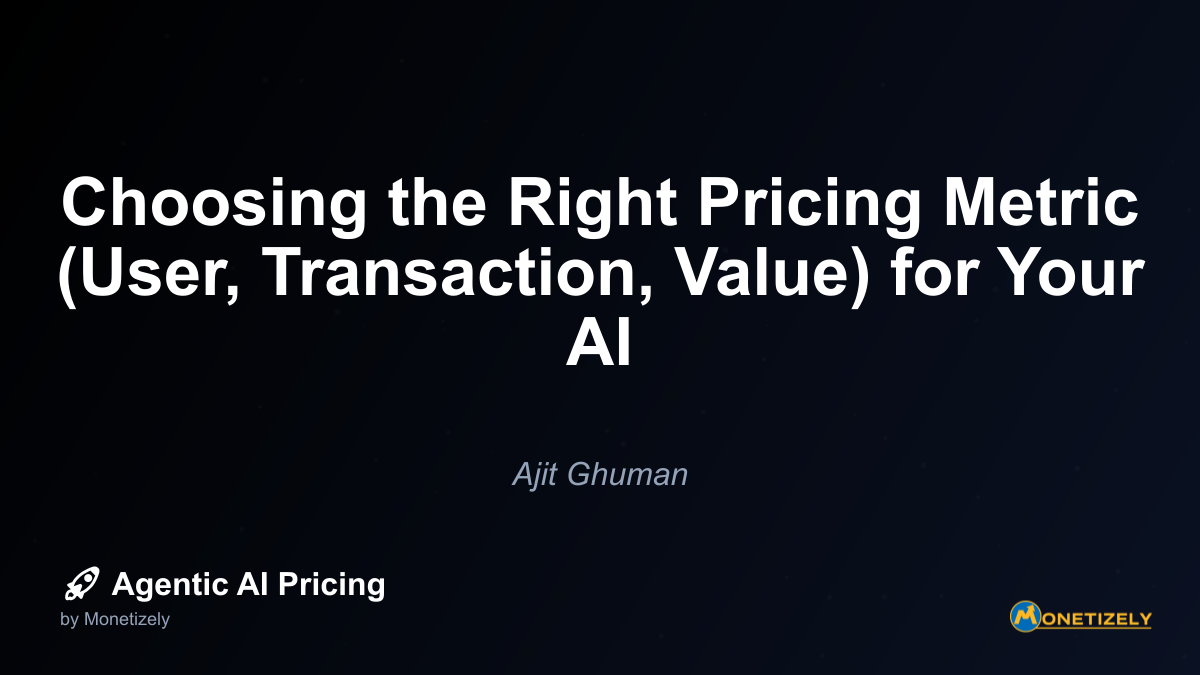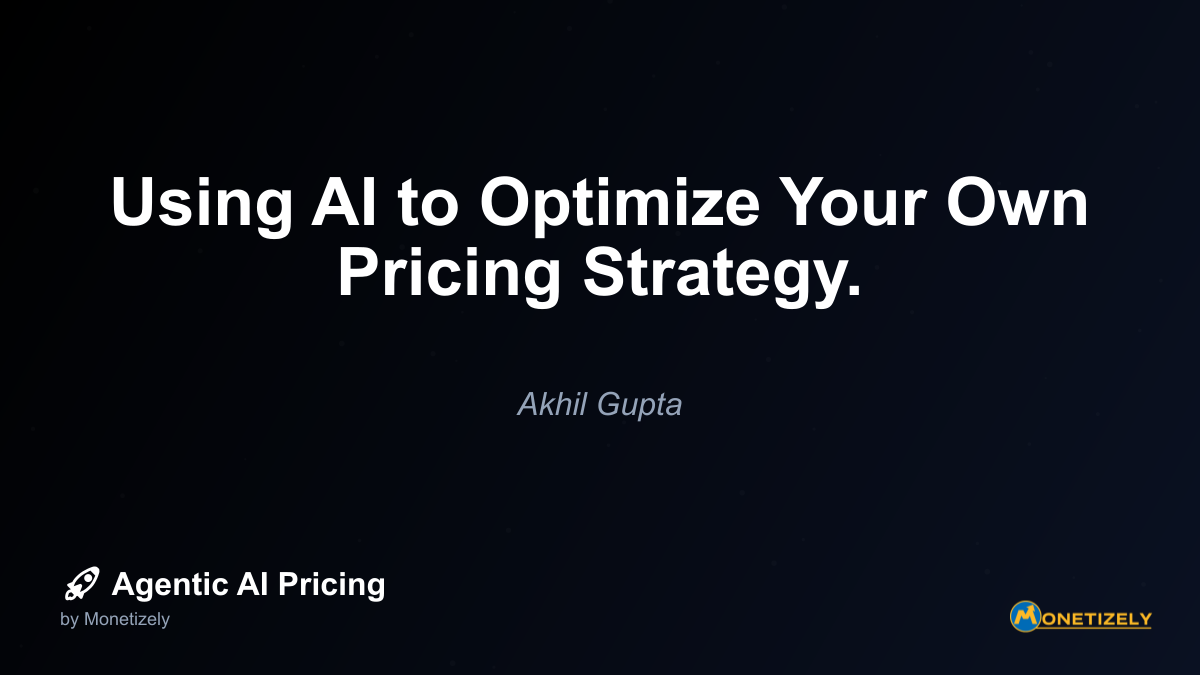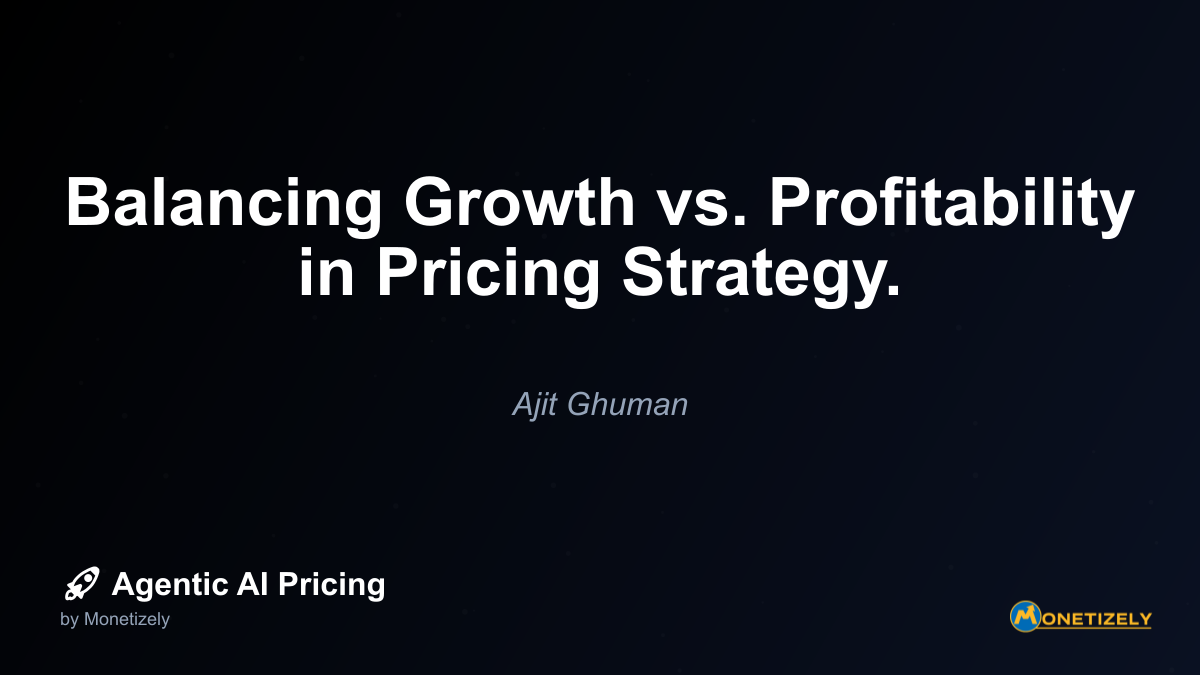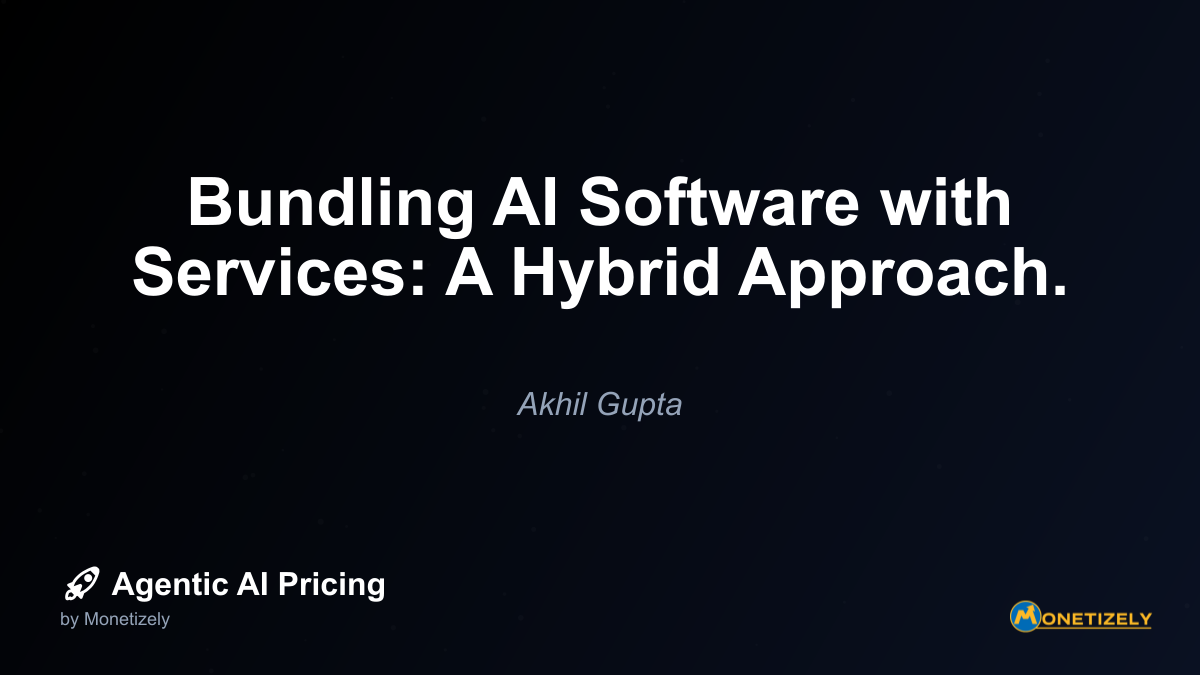· Ajit Ghuman · Strategy & Planning · 7 min read
Go-to-Market for AI Startups: Balancing User Growth and Revenue.
AI and SaaS Pricing Masterclass
Learn the art of strategic pricing directly from industry experts. Our comprehensive course provides frameworks and methodologies for optimizing your pricing strategy in the evolving AI landscape. Earn a professional certification that can be imported directly to your LinkedIn profile.
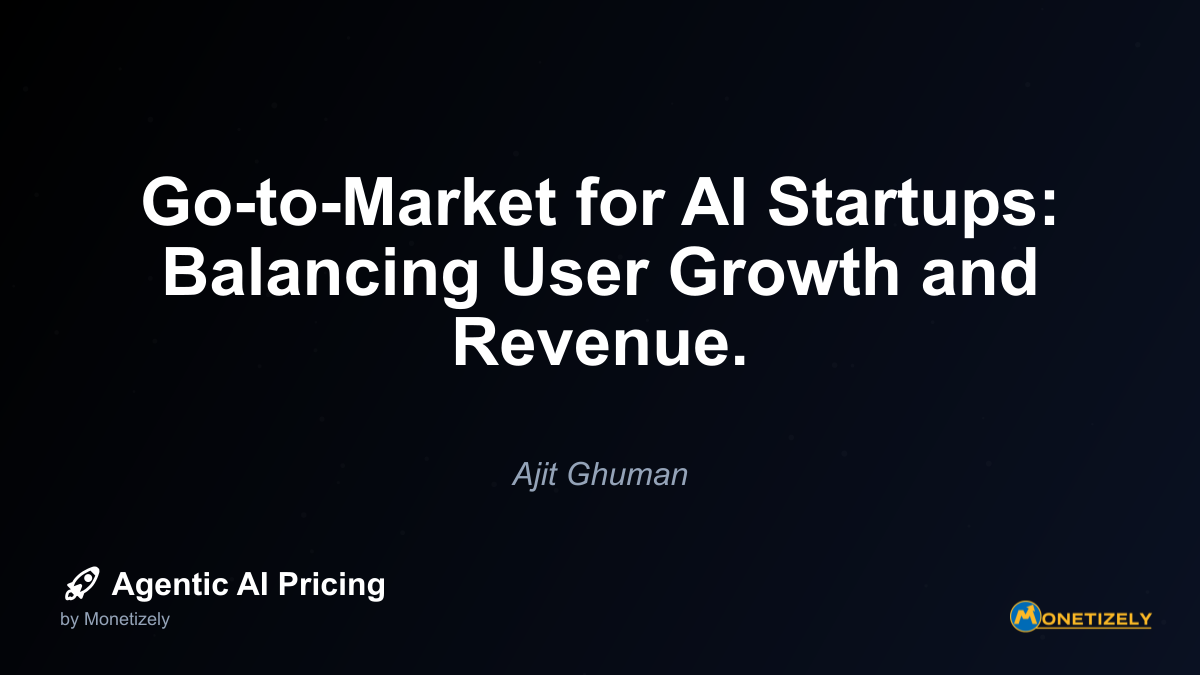
4. Implement Data-Driven Conversion Optimization
Converting free users to paying customers requires systematic experimentation and optimization:
Conversion triggers: Identify natural moments when users experience maximum value from your product
Usage-based prompts: Create contextual upgrade prompts when users approach free tier limits
Value-oriented messaging: Focus communications on business outcomes rather than features
Targeted offers: Develop segment-specific promotions based on usage patterns and company profiles
For deeper insights on freemium models specifically for AI services, this detailed analysis of GenAI freemium strategies explores the delicate balance between offering free tokens and monetizing advanced features.
Data Collection vs. Monetization: Finding the Sweet Spot
The tension between gathering valuable training data and generating revenue represents perhaps the most fundamental challenge for AI startups. Here are approaches to navigate this dilemma:
Selective Data Collection Strategies
Not all user interactions generate equally valuable data. Consider:
Quality-focused collection: Prioritize high-quality data from specific user segments over raw volume
Targeted free access: Offer free services to users in underrepresented domains to improve model performance in those areas
Data partnerships: Establish relationships with organizations that can provide valuable training data in exchange for free or discounted access
Value Exchange Transparency
Users are increasingly aware of the value of their data. Building trust through transparency can improve both data collection and monetization:
Clear data policies: Explicitly communicate how user data improves the product
Opt-in incentives: Offer tangible benefits for users who allow their data to be used for model training
Value visualization: Help users understand how their contributions improve the system for everyone
Hybrid Monetization Models
Rather than choosing between data collection and revenue generation, consider hybrid approaches:
Delayed monetization: Focus initially on data collection, then introduce monetization once the product reaches a certain quality threshold
Segment-specific strategies: Monetize immediately in segments where your AI already performs well, while offering free access in areas where you need more training data
Value-added services: Keep core AI features accessible while charging for complementary services like implementation, customization, or analytics
Case Studies: Successful AI Startup Go-to-Market Strategies
Case Study 1: Stability AI’s Open Access Approach
Stability AI, creator of Stable Diffusion, took a bold approach by open-sourcing their core image generation model while building commercial applications on top.
Strategy Elements:
- Released the base model as open-source, generating massive community adoption
- Built a commercial API service (DreamStudio) with usage-based pricing
- Developed enterprise licensing for commercial applications
- Secured venture funding based on the demonstrated market demand
Results:
- Rapid adoption across the developer community
- Significant model improvements from community contributions
- Established market leadership against well-funded competitors
- Created multiple revenue streams while maintaining goodwill
Case Study 2: Jasper’s Tiered SaaS Model
Jasper (formerly Jarvis) successfully monetized AI-powered content generation through a traditional SaaS approach with AI-specific optimizations.
Strategy Elements:
- Focused on specific use cases (marketing content creation) rather than general AI capabilities
- Implemented tiered pricing based on word output volume
- Provided templates and workflows that simplified adoption
- Emphasized ROI through time savings for marketing teams
Results:
- Achieved unicorn status with $1.5B valuation
- Demonstrated sustainable unit economics
- Successfully transitioned from early adopters to mainstream business users
- Maintained pricing power despite increasing competition
Case Study 3: Hugging Face’s Community-Powered Approach
Hugging Face built a thriving AI ecosystem through open collaboration while developing enterprise offerings.
Strategy Elements:
- Created an open platform for sharing and collaborating on AI models
- Built a community of over 10,000 contributing organizations
- Developed enterprise offerings for model deployment and management
- Positioned as the “GitHub of machine learning”
Results:
- Established as the dominant platform for open-source AI models
- Created network effects that increase switching costs
- Successfully monetized through enterprise services
- Maintained thought leadership in rapidly evolving field
Common Go-to-Market Pitfalls for AI Startups
1. Underpricing Due to Cost Miscalculation
AI applications often have complex and variable cost structures. Many startups fail to account for:
- Inference costs: Processing costs for each user interaction
- Storage requirements: Data retention needs for personalization
- Retraining expenses: Ongoing model improvement costs
- Support complexity: Higher customer support requirements for novel applications
To avoid this pitfall, implement rigorous cost modeling that accounts for scale and integrate cost monitoring into product development.
2. Overestimating Initial Product Quality
AI products often launch with imperfect performance, creating tension between early monetization and user satisfaction.
Mitigation strategies include:
- Expectation management: Clearly communicate the current capabilities and limitations
- Feedback loops: Create structured ways for users to report issues and see improvements
- Value-based positioning: Focus on the specific problems you solve well, not general AI capabilities
- Progressive disclosure: Introduce more complex features as the AI improves
3. Neglecting Customer Education
The novelty of many AI applications means customers often don’t understand how to integrate them into workflows.
Successful approaches include:
- Use case libraries: Provide concrete examples of how others are using your product
- Interactive onboarding: Guide users through their first successful experiences
- ROI calculators: Help prospects quantify the potential value
- Vertical-specific documentation: Create resources tailored to specific industries or roles
For founders seeking a comprehensive framework on pricing decisions, this strategic framework for pricing AI products provides valuable guidance on balancing technical constraints with market positioning.
Building a Balanced Go-to-Market Roadmap
A successful go-to-market strategy for AI startups isn’t static—it evolves as your product, market, and company mature.
Phase 1: Data Collection and Product Validation (0-6 months)
Primary Goal: Gather sufficient data to improve your AI while validating market demand
Key Tactics:
- Limited free access programs for targeted user segments
- Waitlist with selective invitations to balance growth and quality
- Manual support and high-touch onboarding to understand user needs
- Minimal viable monetization to test willingness to pay
Metrics to Track:
- Data quality and diversity metrics
- Model performance improvements over time
- User engagement and retention
- Qualitative feedback on value perception
Phase 2: Initial Monetization (6-12 months)
Primary Goal: Establish sustainable unit economics while maintaining growth
Key Tactics:
- Introduce tiered pricing based on early usage patterns
- Implement strategic feature gates between free and paid tiers
- Develop automated onboarding to reduce customer acquisition costs
- Begin testing different positioning and messaging
Metrics to Track:
- Conversion rates from free to paid
- Customer acquisition costs by channel
- Average revenue per user (ARPU)
- Churn rates and reasons
Phase 3: Scaling and Optimization (12-24 months)
Primary Goal: Accelerate growth while improving monetization efficiency
Key Tactics:
- Refine pricing tiers based on demonstrated value
- Develop expansion revenue strategies for existing customers
- Implement systematic conversion optimization
- Explore new market segments and use cases
Metrics to Track:
- Net revenue retention
- Expansion revenue percentage
- Customer lifetime value
- Payback period on customer acquisition
Phase 4: Enterprise Expansion (24+ months)
Primary Goal: Capture enterprise value while maintaining product innovation
Key Tactics:
- Develop enterprise-specific features (security, compliance, etc.)
- Create professional services offerings for complex implementations
- Implement account-based marketing for target enterprises
- Build partner ecosystems for distribution and implementation
Metrics to Track:
- Enterprise deal sizes and sales cycles
- Implementation success rates
- Partner-sourced revenue percentage
- Competitive win/loss ratios
Conclusion: Finding Your Unique Balance
The tension between user growth and revenue generation isn’t a problem to solve once—it’s an ongoing balancing act that requires continuous adjustment. The most successful AI startups approach this challenge with flexibility, data-driven decision making, and a deep understanding of their specific market dynamics.
Rather than copying established playbooks, develop a go-to-market strategy that reflects your unique circumstances:
Assess your data requirements: How much user data do you need to reach acceptable performance?
Understand your cost structure: What are your variable costs per user? How do they scale?
Map your customer journey: How long does it take for users to experience meaningful value?
Evaluate competitive dynamics: How are similar solutions priced? What free alternatives exist?
Consider your funding situation: What runway do you have to prioritize growth over immediate revenue?
By thoughtfully addressing these questions, you can craft a go-to-market approach that drives both the user adoption necessary for AI improvement and the revenue generation essential for business sustainability. The most successful AI startups don’t see this as an either/or proposition—they build strategies that systematically convert user growth into revenue while using that revenue to fund improvements that attract more users.
In the rapidly evolving AI landscape, the winners will be those who master this virtuous cycle, creating sustainable businesses that deliver continuously improving value to their customers.
Co-Founder & CEO
Ajit is the author of Price To Scale, a top book on SaaS Pricing and is the Founder of Monetizely. Ajit has led and worked in pricing and product marketing at firms like Twilio, Narvar and Medallia. His work has been featured in Forbes and VentureBeat. Ajit regularly consults with software companies from Seed stage to post-IPO on pricing strategy. Ajit is also a highly-rated co-instructor for 'The Art of SaaS Pricing and Monetization' on Maven.
Pricing Strategy Audit
Let our experts analyze your current pricing strategy and identify opportunities for improvement. Our data-driven assessment will help you unlock untapped revenue potential and optimize your AI pricing approach.

